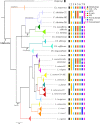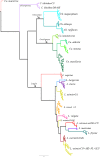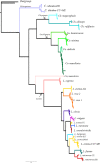DNA-barcoding of forensically important blow flies (Diptera: Calliphoridae) in the Caribbean Region
- PMID: 28761780
- PMCID: PMC5531032
- DOI: 10.7717/peerj.3516
DNA-barcoding of forensically important blow flies (Diptera: Calliphoridae) in the Caribbean Region
Abstract
Correct identification of forensically important insects, such as flies in the family Calliphoridae, is a crucial step for them to be used as evidence in legal investigations. Traditional identification based on morphology has been effective, but has some limitations when it comes to identifying immature stages of certain species. DNA-barcoding, using COI, has demonstrated potential for rapid and accurate identification of Calliphoridae, however, this gene does not reliably distinguish among some recently diverged species, raising questions about its use for delimitation of species of forensic importance. To facilitate DNA based identification of Calliphoridae in the Caribbean we developed a vouchered reference collection from across the region, and a DNA sequence database, and further added the nuclear ITS2 as a second marker to increase accuracy of identification through barcoding. We morphologically identified freshly collected specimens, did phylogenetic analyses and employed several species delimitation methods for a total of 468 individuals representing 19 described species. Our results show that combination of COI + ITS2 genes yields more accurate identification and diagnoses, and better agreement with morphological data, than the mitochondrial barcodes alone. All of our results from independent and concatenated trees and most of the species delimitation methods yield considerably higher diversity estimates than the distance based approach and morphology. Molecular data support at least 24 distinct clades within Calliphoridae in this study, recovering substantial geographic variation for Lucilia eximia, Lucilia retroversa, Lucilia rica and Chloroprocta idioidea, probably indicating several cryptic species. In sum, our study demonstrates the importance of employing a second nuclear marker for barcoding analyses and species delimitation of calliphorids, and the power of molecular data in combination with a complete reference database to enable identification of taxonomically and geographically diverse insects of forensic importance.
Keywords: Calliphoridae; Caribbean; DNA-barcoding; Diptera; Forensic entomology.
Conflict of interest statement
The authors declare there are no competing interests.
Figures




Similar articles
-
Forensically Relevant Blow Flies in Lebanon Survey and Identification Using Molecular Markers (Diptera: Calliphoridae).J Med Entomol. 2018 Aug 29;55(5):1113-1123. doi: 10.1093/jme/tjy068. J Med Entomol. 2018. PMID: 29762744
-
DNA barcoding of forensically important flies in the Western Cape, South Africa.Genome. 2018 Dec;61(12):823-828. doi: 10.1139/gen-2018-0054. Epub 2018 Oct 2. Genome. 2018. PMID: 30278145
-
Identification of Forensically Important Blow Flies (Diptera: Calliphoridae) in China Based on COI.J Med Entomol. 2017 Sep 1;54(5):1193-1200. doi: 10.1093/jme/tjx105. J Med Entomol. 2017. PMID: 28535279
-
Review of Molecular Identification Techniques for Forensically Important Diptera.J Med Entomol. 2019 Jun 27;56(4):887-902. doi: 10.1093/jme/tjz040. J Med Entomol. 2019. PMID: 31173634 Review.
-
DNA-based identification of forensically important Chrysomyinae (Diptera: Calliphoridae).Forensic Sci Int. 2001 Aug 15;120(1-2):110-5. doi: 10.1016/s0379-0738(01)00414-5. Forensic Sci Int. 2001. PMID: 11457617 Review.
Cited by
-
Evidence of two mitochondrial lineages and genetic variability in forensically important Lucilia eximia (Diptera: Calliphoridae) in Colombia.J Med Entomol. 2023 Jul 12;60(4):656-663. doi: 10.1093/jme/tjad031. J Med Entomol. 2023. PMID: 37071084 Free PMC article.
-
Discobola Osten Sacken, 1865 (Diptera, Limoniidae) in China: Taxonomic Review, Updated Distribution, and DNA Barcoding.Insects. 2025 Aug 15;16(8):845. doi: 10.3390/insects16080845. Insects. 2025. PMID: 40870646 Free PMC article.
-
Do longer sequences improve the accuracy of identification of forensically important Calliphoridae species?PeerJ. 2018 Dec 17;6:e5962. doi: 10.7717/peerj.5962. eCollection 2018. PeerJ. 2018. PMID: 30588393 Free PMC article.
-
Identification of Diptera Puparia in Forensic and Archeo-Funerary Contexts.Insects. 2024 Aug 8;15(8):599. doi: 10.3390/insects15080599. Insects. 2024. PMID: 39194804 Free PMC article. Review.
-
Virus discovery in all three major lineages of terrestrial arthropods highlights the diversity of single-stranded DNA viruses associated with invertebrates.PeerJ. 2018 Oct 11;6:e5761. doi: 10.7717/peerj.5761. eCollection 2018. PeerJ. 2018. PMID: 30324030 Free PMC article.
References
-
- Agnarsson I. The utility of ITS2 in spider phylogenetics: notes on prior work and an example from Anelosimus. Journal of Arachnology. 2010;38:377–382. doi: 10.1636/B10-01.1. - DOI
-
- Aguiar-Coelho VM, Milward-De-Azevedo EMV. Combined rearing of Cochliomyia macellaria (Fabr.), Chrysomya megacephala (Fabr.) and Chrysomya albiceps (Wied.) (Dipt, Calliphoridae) under laboratory conditions. Journal of Applied Entomology-Zeitschrift Fur Angewandte Entomologie. 1998;122:551–554.
-
- Anslan S, Tedersoo L. Performance of cytochrome c oxidase subunit I (COI), ribosomal DNA Large Subunit (LSU) and Internal Transcribed Spacer 2 (ITS2) in DNA barcoding of Collembola. European Journal of Soil Biology. 2015;69:1–7. doi: 10.1016/j.ejsobi.2015.04.001. - DOI
LinkOut - more resources
Full Text Sources
Other Literature Sources

